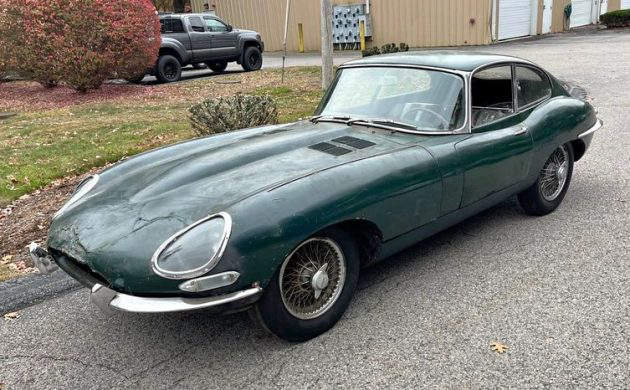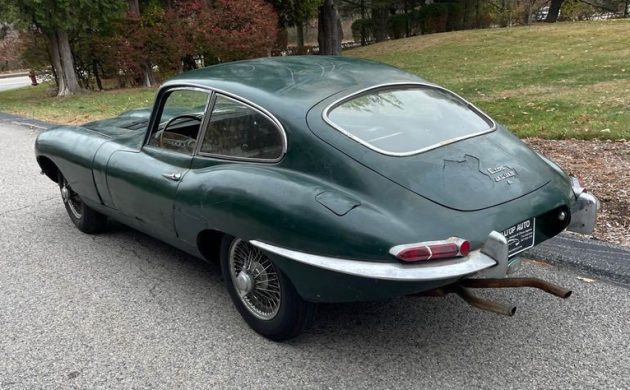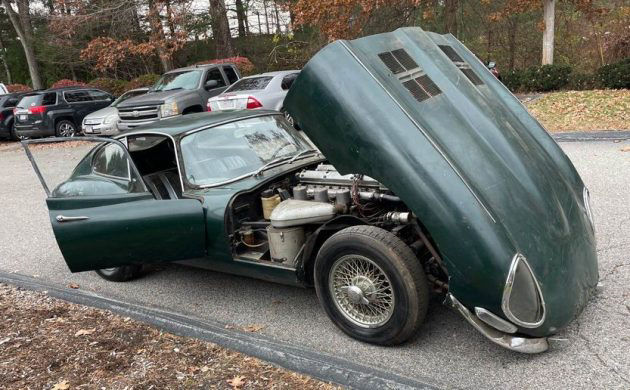Restoration Required: 1967 Jaguar E-Type
Although the values of some versions have taken a recent hit, a pristine Series 1 Jaguar E-Type can still command a healthy six-figure price. They are keenly sought by enthusiasts wishing to experience life behind the wheel of a classic British sports car designed to challenge the best offered by the company’s European opposition. This 1967 Fixed Head Coupe requires plenty of work to return to its former glory, although it appears to be complete, and has avoided the rust issues that often plagued these classics. The seller has listed the E-Type here on Facebook Marketplace in Hanover, Massachusetts. They set their price at $36,500, so let’s take a look to determine whether the figure is justified.
Thousands (or possibly millions) of words have been written about the impact the E-Type had when it was unveiled, and I’m not going to add much to that story. The styling captured the hearts of journalists and the buying public, and it only took a few minutes behind the wheel to discover that Jaguar’s sports car was more than just a pretty face. The history of our feature car is unclear, and I believe that the British Racing Green paint gracing its panels may not be original. The shade was available throughout E-Type production, but I have spotted a couple of small areas where the existing paint has peeled to reveal what seems to be Sherwood Green. This is conceivable because the 1967 model year was the last when Jaguar offered that color. The overall deterioration will probably prompt the new owner to strip the steel to bare metal, although the potential value locked away in this E-Type would make a nut-and-bolt restoration worthwhile. The biggest question hanging over any E-Type of this vintage revolves around the potential presence of penetrating rust. Reproduction steel to address such problems is readily available, but it might not be required on this occasion. Prone areas like the lower quarters and hatch opening look clean. The interior is missing its carpet, providing a relatively clear view of the floors. There is surface corrosion, but no evidence of holes. The trim and headlamp covers are intact, and the glass looks pretty good.
The seller is sparing with information in their listing, meaning that it is unclear whether this is a numbers-matching vehicle. Its mechanical health is unknown, but the drivetrain appears complete. The beautiful 4.2-liter DOHC six would have produced 266hp and 283 ft/lbs of torque in its prime. It found its way to the road via a four-speed manual transmission, but Jaguar created these cars as a “total” package. Therefore, not only were they fast in a straight line, but the four-wheel independent suspension and disc brakes ensured that the handling and stopping power were as impressive as the outright performance. The journey down the ¼-mile would have taken 14.9 seconds while giving this car a free rein would have seen the needle nudge 149mph. It will undoubtedly require work to reach those lofty standards, but if the engine turns, a rebuild should be possible.
There’s no way to sugar-coat this because this Jaguar’s interior requires a complete retrim. Kits in the correct Black leather aren’t hard to find, but they do cost over $5,000. That is a lot of money for a single aspect of this build, but such work is typically a one-off expense. If treated respectfully and maintained appropriately, the trim should present beautifully for many decades. What I find appealing about this car is its dash. Jaguar introduced what is unofficially known as the Series 1½ version in 1967, unveiling some of the changes required to comply with emerging government regulations. The most obvious inside these classics was the replacement of the dash’s beautiful and traditional toggle switches with rockers. This E-Type pre-dates those changes, and I have always believed that the toggles found in this car are exactly what a classic British sports car should feature.
Although 1967 Jaguar E-Types requiring restoration have experienced a drop in value, those at the top end of the market have continued to flourish. Six-figure prices are quite common, and we’re not talking about situations where they barely sneak beyond the $100,000 mark. This Fixed Head Coupe requires an enormous amount of love to reach that point, but as a desirable Series 1 version, it would seem to be justified. Every aspect of this car demands attention, and the process won’t be cheap. However, if it is a rust-free classic, there is a good chance that it will be financially viable. Is that a chance you are willing to take?
Auctions Ending Soon
 1971 Ford Mustang Mach 1Bid Now16 hours$7,100
1971 Ford Mustang Mach 1Bid Now16 hours$7,100
 2003 Porsche Boxster SBid Now17 hours$6,250
2003 Porsche Boxster SBid Now17 hours$6,250
 1966 Lincoln ContinentalBid Now19 hours$500
1966 Lincoln ContinentalBid Now19 hours$500
 2000 Jaguar XJ8LBid Now4 days$1,250
2000 Jaguar XJ8LBid Now4 days$1,250
 1977 Datsun 280ZBid Now5 days$275
1977 Datsun 280ZBid Now5 days$275






Comments
Is it just me, or do those seat bottoms look like they were slashed with a big knife.
Yes.
Love the toggle switches….best thing about older British cars, IMHO.
Those seats look like an angry ex taking revenge….
Everytime I see one of these I can’t get over how awful the proportions are. It looks like a large creature stepped on it and then kicked it in the ass.